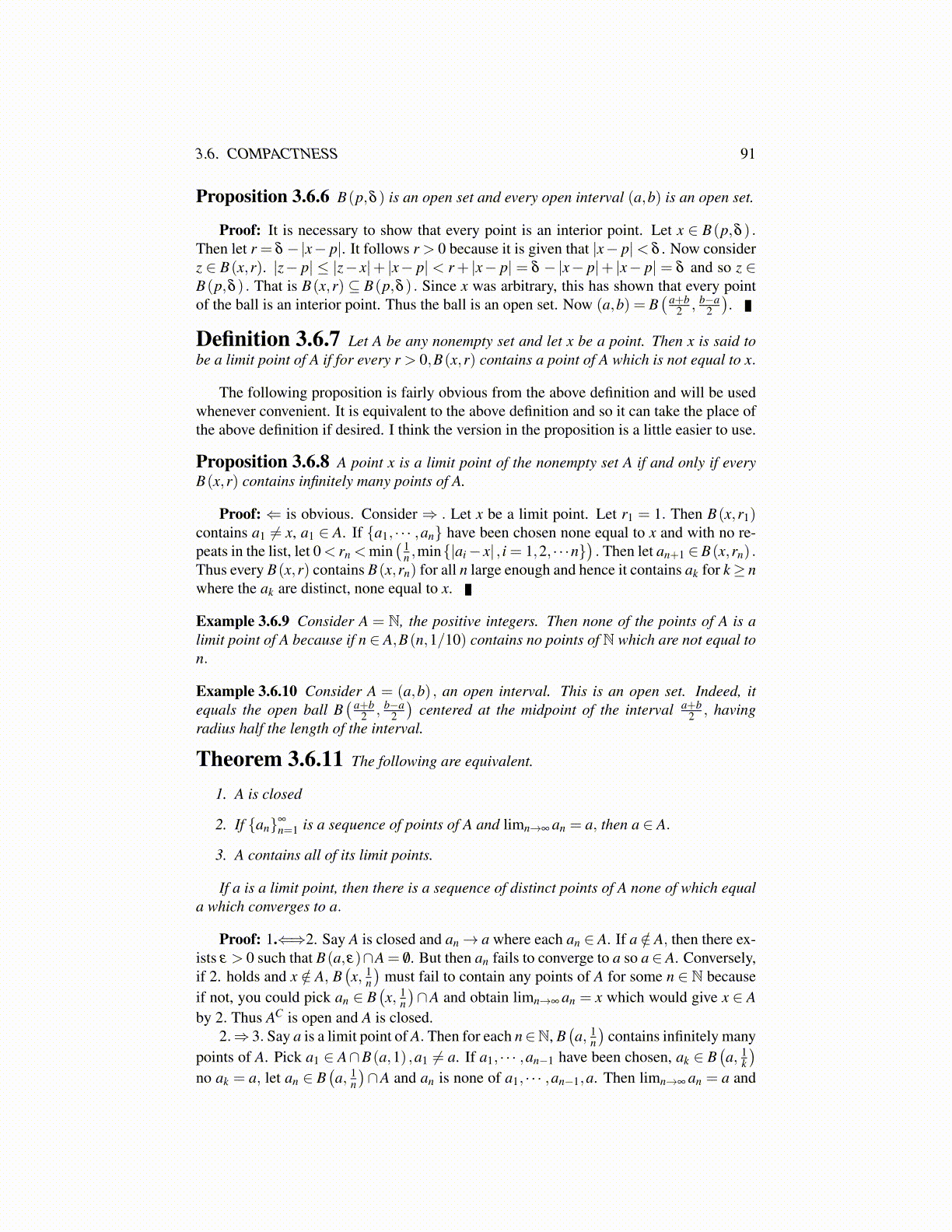
3.6. COMPACTNESS 91
Proposition 3.6.6 B(p,δ ) is an open set and every open interval (a,b) is an open set.
Proof: It is necessary to show that every point is an interior point. Let x ∈ B(p,δ ) .Then let r = δ −|x− p|. It follows r > 0 because it is given that |x− p|< δ . Now considerz ∈ B(x,r). |z− p| ≤ |z− x|+ |x− p| < r+ |x− p| = δ −|x− p|+ |x− p| = δ and so z ∈B(p,δ ) . That is B(x,r) ⊆ B(p,δ ) . Since x was arbitrary, this has shown that every pointof the ball is an interior point. Thus the ball is an open set. Now (a,b) = B
( a+b2 , b−a
2
).
Definition 3.6.7 Let A be any nonempty set and let x be a point. Then x is said tobe a limit point of A if for every r > 0,B(x,r) contains a point of A which is not equal to x.
The following proposition is fairly obvious from the above definition and will be usedwhenever convenient. It is equivalent to the above definition and so it can take the place ofthe above definition if desired. I think the version in the proposition is a little easier to use.
Proposition 3.6.8 A point x is a limit point of the nonempty set A if and only if everyB(x,r) contains infinitely many points of A.
Proof: ⇐ is obvious. Consider ⇒ . Let x be a limit point. Let r1 = 1. Then B(x,r1)contains a1 ̸= x, a1 ∈ A. If {a1, · · · ,an} have been chosen none equal to x and with no re-peats in the list, let 0< rn <min
( 1n ,min{|ai − x| , i = 1,2, · · ·n}
). Then let an+1 ∈B(x,rn) .
Thus every B(x,r) contains B(x,rn) for all n large enough and hence it contains ak for k ≥ nwhere the ak are distinct, none equal to x.
Example 3.6.9 Consider A = N, the positive integers. Then none of the points of A is alimit point of A because if n ∈ A,B(n,1/10) contains no points of N which are not equal ton.
Example 3.6.10 Consider A = (a,b) , an open interval. This is an open set. Indeed, itequals the open ball B
( a+b2 , b−a
2
)centered at the midpoint of the interval a+b
2 , havingradius half the length of the interval.
Theorem 3.6.11 The following are equivalent.
1. A is closed
2. If {an}∞
n=1 is a sequence of points of A and limn→∞ an = a, then a ∈ A.
3. A contains all of its limit points.
If a is a limit point, then there is a sequence of distinct points of A none of which equala which converges to a.
Proof: 1.⇐⇒2. Say A is closed and an → a where each an ∈ A. If a /∈ A, then there ex-ists ε > 0 such that B(a,ε)∩A = /0. But then an fails to converge to a so a ∈ A. Conversely,if 2. holds and x /∈ A, B
(x, 1
n
)must fail to contain any points of A for some n ∈ N because
if not, you could pick an ∈ B(x, 1
n
)∩A and obtain limn→∞ an = x which would give x ∈ A
by 2. Thus AC is open and A is closed.2.⇒ 3. Say a is a limit point of A. Then for each n∈N, B
(a, 1
n
)contains infinitely many
points of A. Pick a1 ∈ A∩B(a,1) ,a1 ̸= a. If a1, · · · ,an−1 have been chosen, ak ∈ B(a, 1
k
)no ak = a, let an ∈ B
(a, 1
n
)∩A and an is none of a1, · · · ,an−1,a. Then limn→∞ an = a and